Parent page: Workspace Content Types
Altium Designer, in conjunction with your connected Workspace, caters for the ability to create and manage Excel-based BOM templates (BOM Template Items) in that Workspace. Such BOM templates are created directly within the Workspace, with the relevant Excel template file (*.xls, *.xlsx, *.xlt, *.xltx) uploaded to a revision of a target Item. Once a BOM template has been created (and data saved into a revision of it), it can be reused in future board-level design projects.
In addition, a BOM Template Item can be used as a configuration data item in one or more defined Environment Configurations. An environment configuration is used to constrain a designer's Altium NEXUS working environment to only use company-ratified design elements. Environment configurations are defined and stored within the Team Configuration Center – a service provided through the Workspace, and the facilitator of this concept of Environment Configuration Management. For more information, see Environment Configuration Management (for an Altium 365 Workspace or a NEXUS Server Workspace).
Folder Type
When creating the folder in which to store BOM templates, you can specify the folder's type. This has no bearing on the content of the folder – uploading will always result in a BOM Template Item. It simply provides a visual 'clue' as to what is stored in a folder and can be beneficial when browsing a Workspace for particular content. To nominate a folder's use as a container for BOM templates, set its Folder Type as BOM Templates, when defining the folder properties in the Edit Folder dialog.
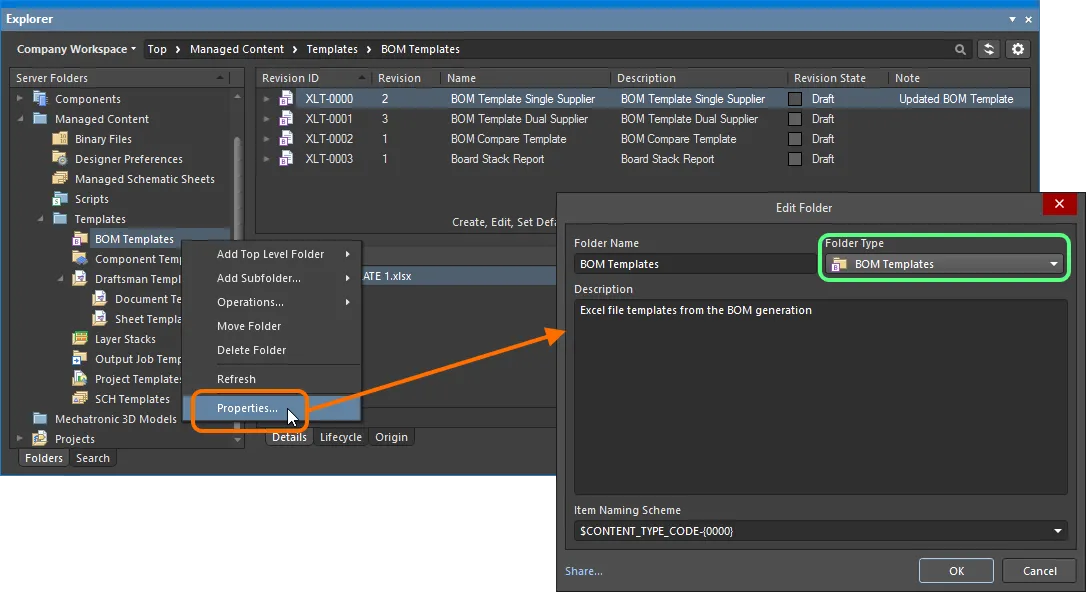
Specifying the folder type – its intended use – gives a visual indication of the content of that folder when browsing the Workspace.
Item Naming Scheme
Another important aspect of the parent folder is the Item Naming Scheme employed for it. This defines the format of the unique ID for each Item created in that particular folder. Several default example schemes are available, utilizing the short-form code for either the folder type (XLT – Excel Templates) or the content type (XLT – Excel Template):
$CONTENT_TYPE_CODE-001-{0000} – for example, XLT-001-0001.$CONTENT_TYPE_CODE-001-{A00} – for example, XLT-001-A01.$FOLDER_TYPE_CODE-001-{0000} – for example, XLT-001-0001.$FOLDER_TYPE_CODE-001-{A000} – for example, XLT-001-A001.
Using a default naming scheme, the software will automatically assign the next available unique ID, based on that scheme, having scanned the entire Workspace and identifiers of existing content. This can be a great time-saver when manually creating BOM templates.
A custom scheme can also be defined for a folder, simply by typing it within the field, ensuring that the variable portion is enclosed in curly braces (e.g. XLBOM-001-{0000}).
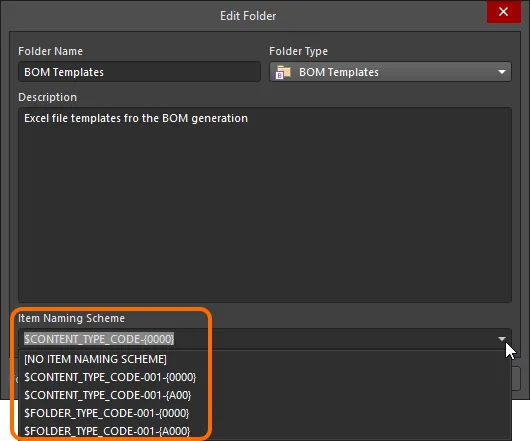
The Item Naming Scheme of the parent folder is applied to the Unique ID for each Item created within that folder.
The Item Naming Scheme employed for the parent folder can be changed at any time. The modified scheme will then be applied to any subsequent newly-created content within that folder.
Content Type
When creating the target BOM Template Item in which to store your Excel template file, ensure that its Content Type is set to BOM Template in the Create New Item dialog. If you are creating the Item in a BOM Templates type folder, this content type will be available from the right-click context menu when creating the Item.
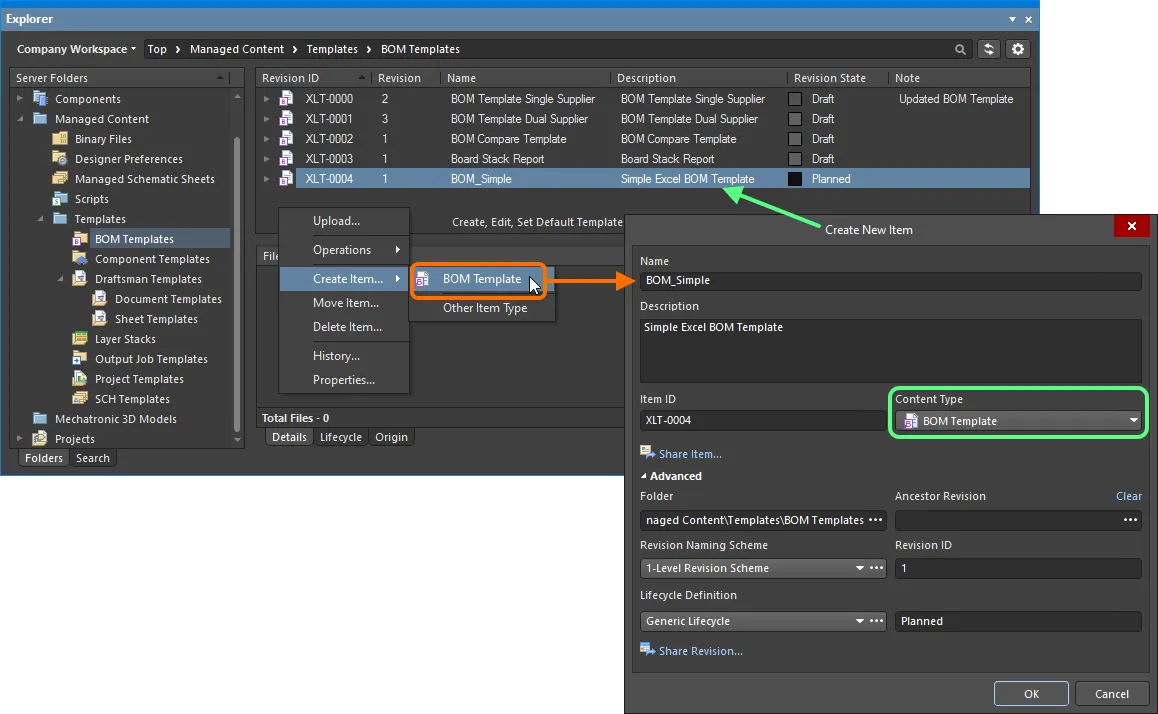
Creating a BOM template within a BOM Templates folder – the correct Content Type is available on the context menu.
Item Lifecycle Definition and Revision Naming
When defining the BOM Template Item, to which the source Excel template file is uploaded, be sure to specify the type of lifecycle management to be used for the Item, and the naming scheme employed for its revisions, respectively.
Control over which content types can use a particular lifecycle definition or revision naming scheme, can be defined and enabled at a global level from within the Content Types dialog, when defining each schema. The default schemes assigned for use by a BOM template are: Generic Lifecycle and 1-Level Revision Scheme, respectively.
Once a file has been uploaded into the initial revision of a BOM Template Item, these schemes cannot be changed for that particular Item.
Specify the required schemes in the Create New Item dialog, using the Lifecycle Definition and Revision Naming Scheme fields respectively.
If the option to control use of lifecycle definitions and revision naming schemes per content type is enabled for any definitions/schemes, and the BOM Template content type is not set to use a particular definition/scheme, then that definition/scheme will not be available in the applicable drop-down list.
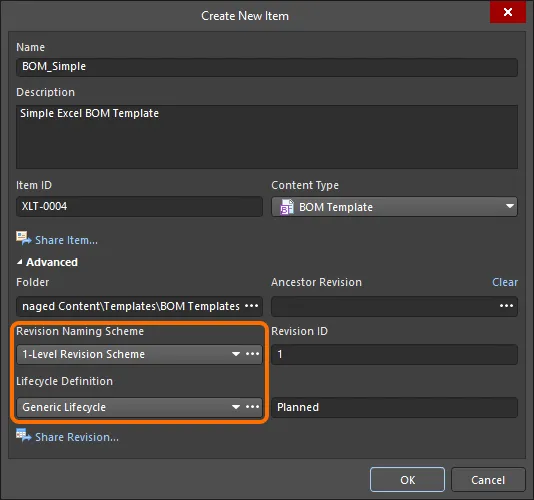
Selecting the Lifecycle Definition and Revision Naming schemes for a manually created BOM template.
Observing standard revision naming schemes and lifecycle definitions, across the various types of design content in a Workspace ensures smooth, consistent management of this content.
It is a good idea to add a Name and Description as part of the BOM template's definition. This information is used when searching the Workspace and enables quick identification of what a BOM template offers.
Uploading a BOM Template File
So far, we've discussed the support for a BOM template in the Workspace, in terms of related folder and content types. Uploading an Excel template file into the revision of a BOM Template can be performed in a couple of ways.
Upload Menu
An Excel template file can be uploaded by right-clicking on the required BOM Template Item in the Explorer panel, and choosing the Upload command from the context menu. The Create New Revision dialog will appear, in which you can change Name, Description, and add release notes as required. Use the Sources region of the dialog to load the required template file. This can be performed by dragging and dropping the file from Windows Explorer, onto the region. Alternatively, click the  button – the Add Files dialog (a standard Windows open-type dialog) will appear. Use this to browse to, and open, the required template file (supported formats/extensions are:
button – the Add Files dialog (a standard Windows open-type dialog) will appear. Use this to browse to, and open, the required template file (supported formats/extensions are: *.xls, *.xlsx, *.xlt, and *.xltx).
If the Item has no planned revision, upload will be to the next planned revision, created on-the-fly as part of the upload process.
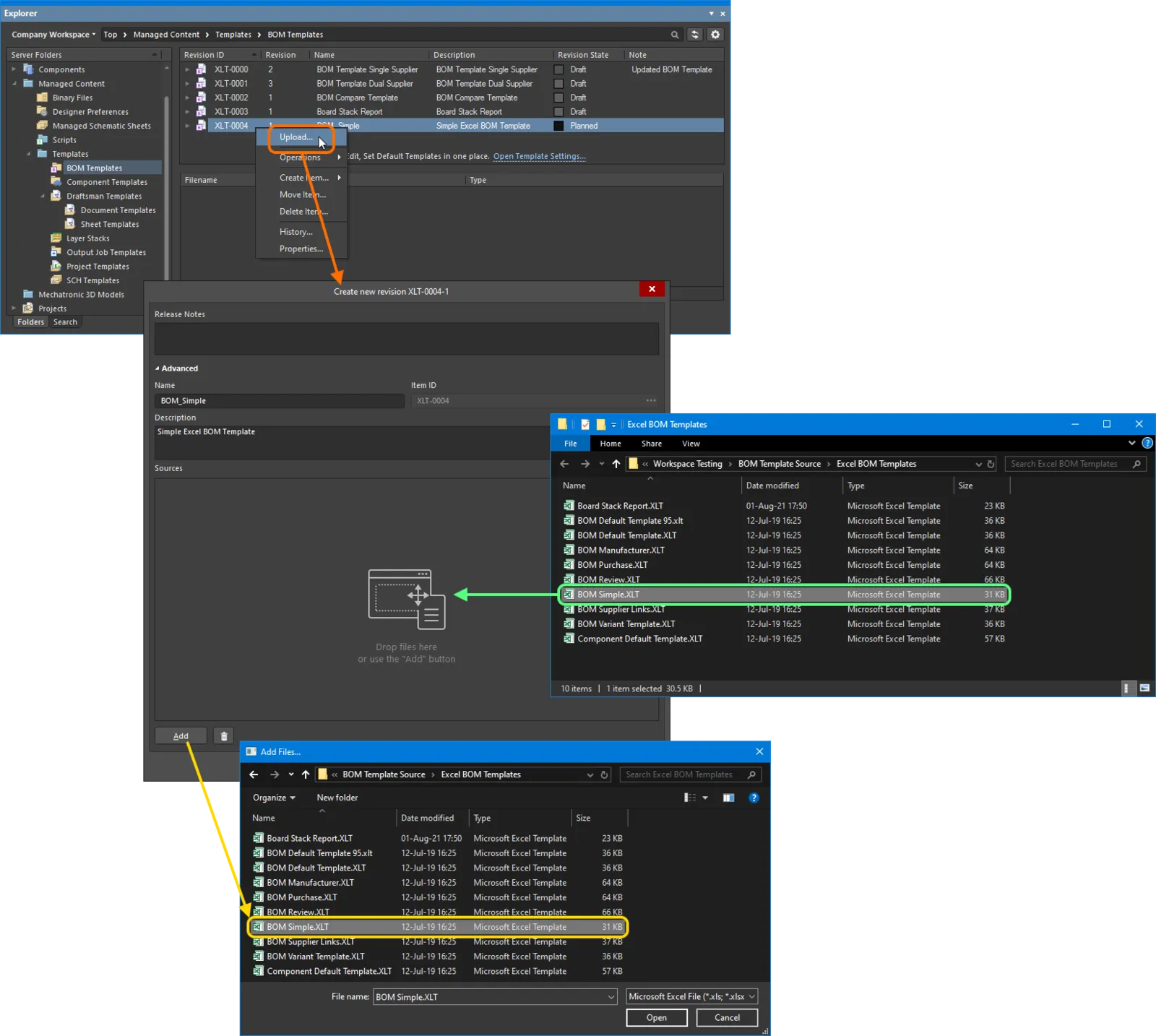
Manually specifying the Excel template file to be uploaded to the target BOM Template Item.
Once the desired file is dropped in, or selected and the Open button clicked, an entry for it will appear back in the Sources region. Proceed with the upload by clicking the OK button. The uploaded file will be available on the Details aspect view tab for the Item Revision, in the Explorer panel.
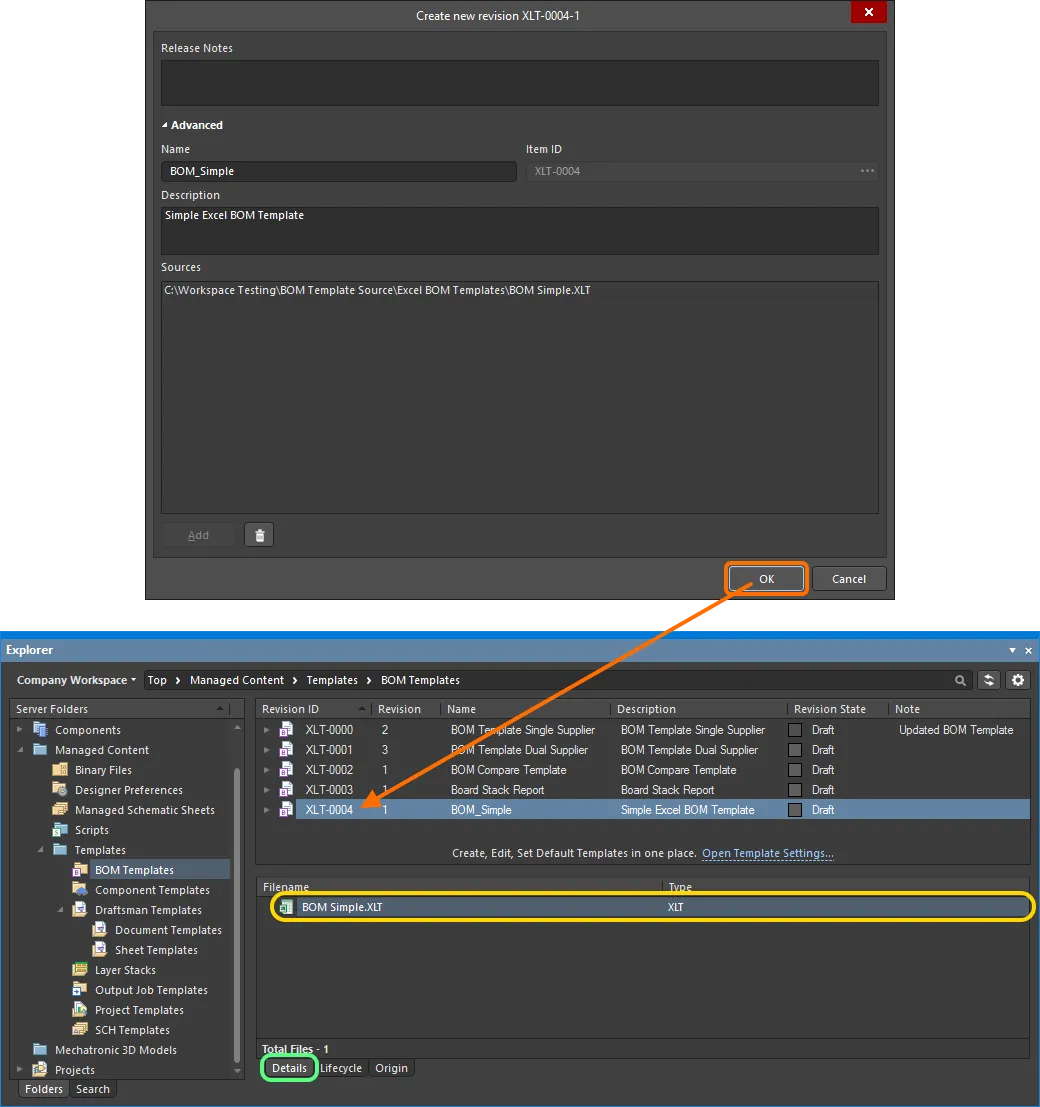
The uploaded file is listed on the Details aspect view tab for the revision of the BOM Template Item.
An Excel template file can also be uploaded using the
Upload command from the context menu of the selected BOM temaplte on the
Templates tab of the
Data Management – Templates page of the
Preferences dialog. Use the
Open dialog (a standard Windows open-type dialog) that opens to browse to, and open, the required file that will be uploaded into the next revision of the BOM Template Item.
Drag and Drop from Windows Explorer
An Excel template file can also be uploaded by dragging the selected file from a source folder in your Windows Explorer, and dropping onto the required target BOM Template Item in the Explorer panel. The Create New Revision dialog will appear, with the dragged file listed in the Sources region. Modify Name (which will be the file name, including extension) and Description (which will be in the format Uploaded from <FileNameandPath>, Size <FileSize>, Created on <FileCreationDate>), and add any Release Notes as required, and then click the OK button.
If the existing BOM Template Item has no planned revision, upload will be to the next planned revision, created on-the-fly as part of the upload process. If you drop the dragged file away from an existing Item, a new BOM Template Item will be created. The
Create New Item dialog will appear. The
Name of the Item will be the file name, including extension. The
Description will be in the format
Uploaded from <FileNameandPath>, Size <FileSize>, Created on <FileCreationDate>. Change these as required. The
Item ID will be in accordance with the Item Naming scheme defined at the folder level. If the folder has no naming scheme defined, naming will follow the
$CONTENT_TYPE_CODE-{000000} scheme.
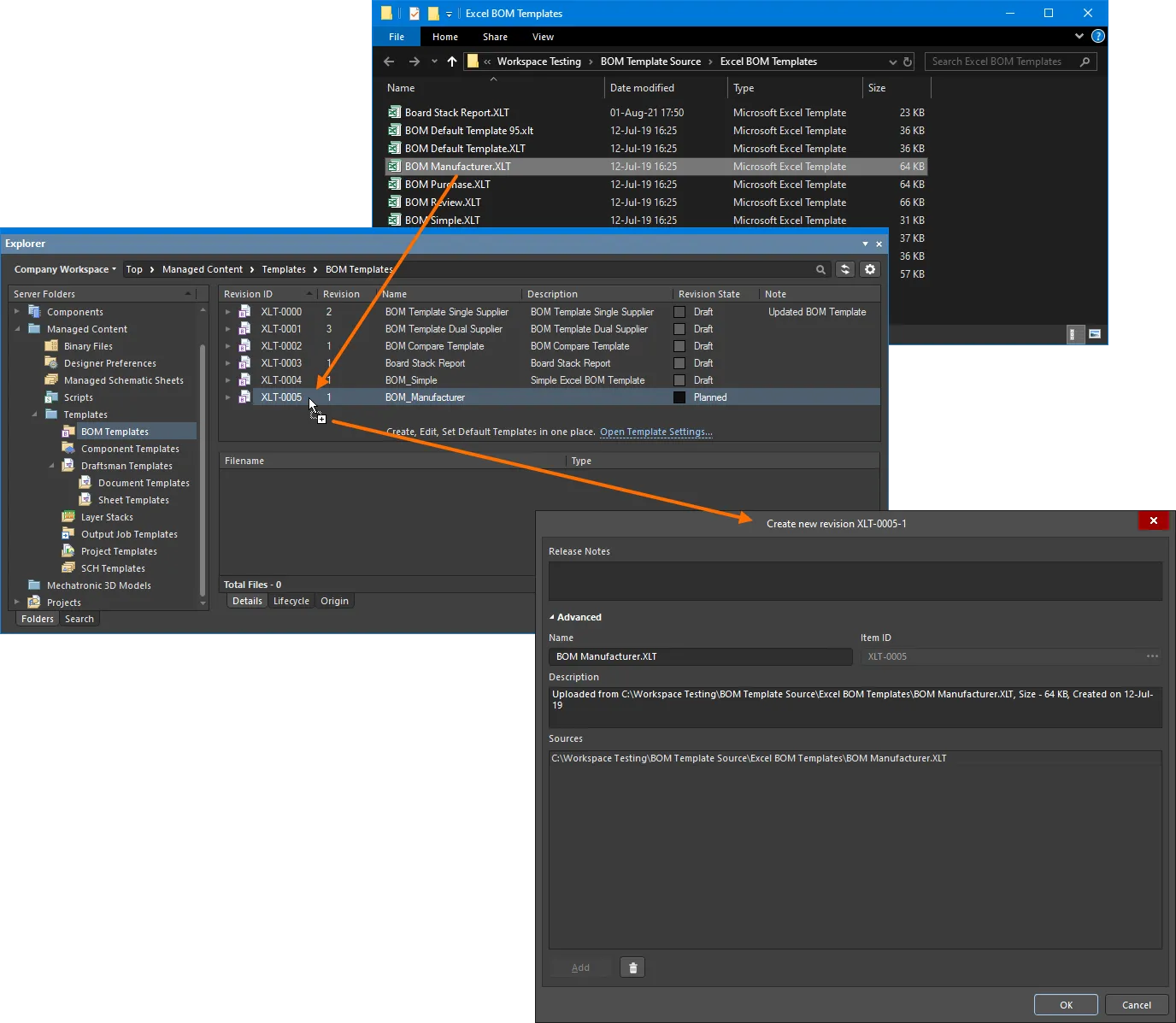
Uploading an Excel template file using the drag and drop method.
You can also create a new BOM template using the BOM or Load from File command from the menu of the Add button or the Add context menu of the template grid on the Templates tab of the Data Management – Templates page of the Preferences dialog. In the Open dialog (a standard Windows open-type dialog) that opens, select the Microsoft Excel File (*.xlt;*.xltx;*.xltm;*.xls;*.xlsx;*.xlsm) option in the drop-down at the right of the File name field and use the dialog to browse to, and open, the required file that will be uploaded into the initial revision of the new BOM Template Item created automatically in a Workspace folder of the BOM Templates type.
If the required Excel template file resides in the Local Template folder (denoted at the bottom of the Data Management – Templates page) and is listed under the Local entry of the template grid, it can be migrated to a new BOM Template by right-clicking on it and selecting the Migrate to Server command. Click the OK button in the Template migration dialog to proceed with the migration process – as stated in this dialog, the original Excel template file will be added to a Zip archive in the local template folder (and hence it will not be visible under the Local template list).
Reusing a BOM Template
Related page: Controlling Access to Workspace Content
Once an Excel BOM template file has been uploaded to a Workspace, and its lifecycle state set to a level that the organization views as ready for use at the design level, that BOM template can be reused in future board-level design projects.
When you are connected to your Workspace, use of available BOM Template Items is automatic. If there are saved revisions of BOM templates, then only those available templates – shared with you – will be presented in the Bill of Materials dialog, through the dialog's Template field (in the Export Options region of the Properties pane, when the MS-Excel, or Generic XLS formats are chosen):
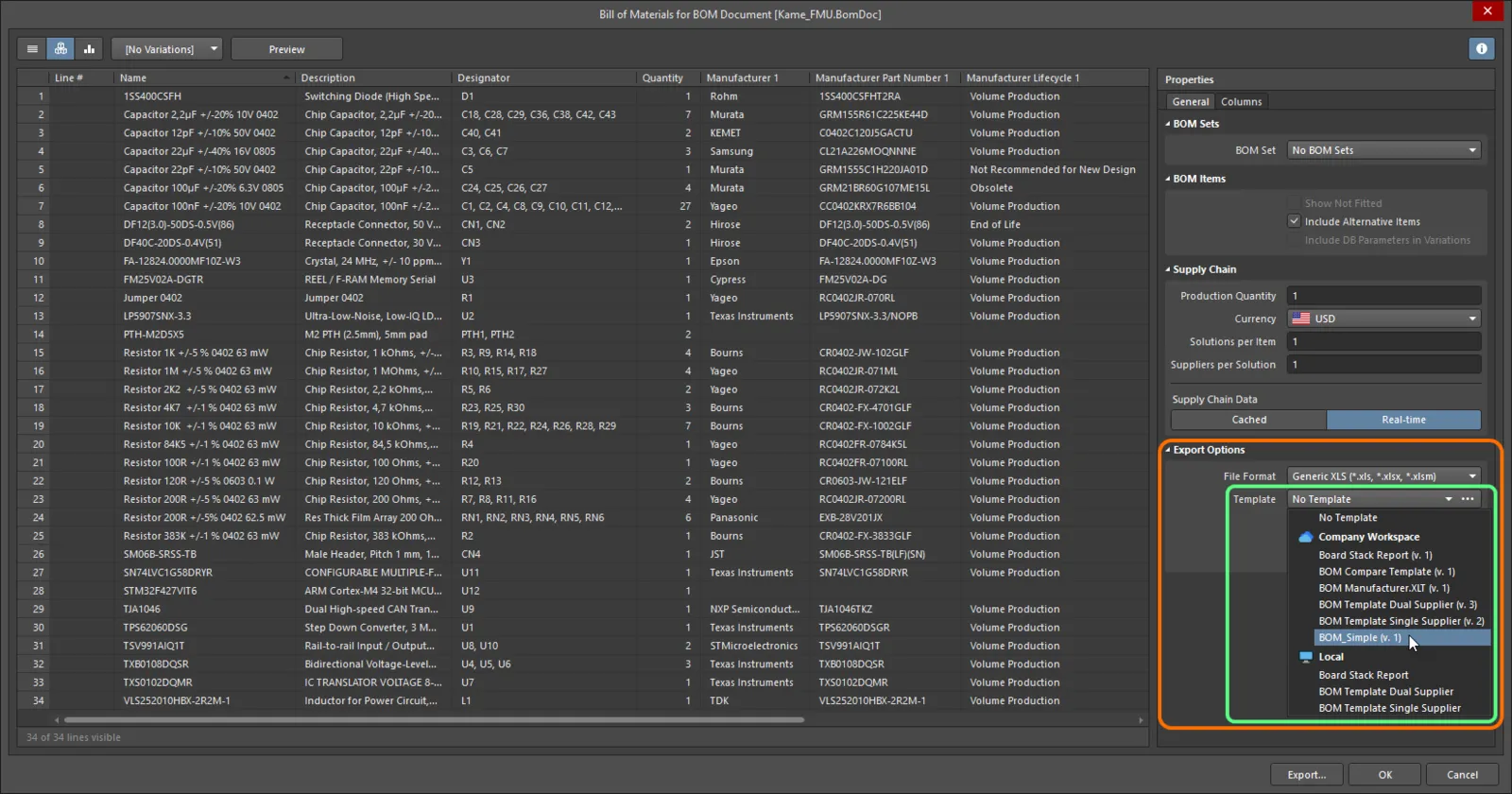
If BOM Template Items exist, then when connected to the Workspace they will be presented under the entry of this Workspace, when configuring a Bill of Materials Report.
If you do not connect to your Workspace you can still work with Altium Designer (under your valid Altium Designer license), but you will not be able to access your organization's Workspace, or any other services it provides. You will therefore not be able to reuse any Workspace-based BOM templates. You will
only be able to use file-based templates defined locally, and available from the templates folder specified on the
Data Management – Templates page of the
Preferences dialog (if the
Template visibility option is set to
Server & Local on this page).
A released BOM Template can also be used as a configuration data item in one or more defined
Environment Configurations. An environment configuration is used to constrain a designer's Altium NEXUS working environment to only use company-ratified design elements. Environment configurations are defined and stored within the Team Configuration Center – a service provided through the Workspace. Once you have connected to the Workspace, and chosen (if applicable) from the selection of environment configurations available to you, Altium NEXUS will be configured, with respect to use of BOM Templates. If the chosen environment configuration has one or more defined BOM templates, then
only those defined templates can be used. If the chosen environment configuration applicable to you does not have any BOM templates specified/added, or is set to
Do Not Control, then these will remain manually definable. In other words, you are free to use local, file-based templates. For more information, see
Environment Configuration Management (for an
Altium 365 Workspace or a
NEXUS Server Workspace).
Updating a BOM Template
If you need to change the Excel template stored in a BOM Template Item, upload the required new template file to that Item – the new template will be stored in the next revision of that Item.
Downloading a BOM Template File
Downloading the Excel BOM Template file (*.xls, *.xlsx, *.xlt, *.xltx) stored in a revision of a BOM template can be performed from the Explorer panel in the following ways:
-
By right-clicking on that revision and choosing the Operations » Download command from the context menu. The file will be downloaded into a sub-folder under the chosen directory, named using the Item Revision ID. The file can be found in the Released folder therein.
Access the Download command from the top-level entry for a BOM template itself, to download the Excel BOM Template file stored in the latest revision of that BOM Template.
Click the Explore button in the Download from Server dialog, to quickly explore to the download folder.
- By selecting the file for the Item Revision, on its Details aspect view tab, right-clicking, and choosing the Download command from the context menu. Nominate the target folder to receive the file, in the subsequent Choose destination folder dialog.
Opening a BOM Template File
To open a BOM Template file that is stored in a revision of a BOM template, select that file – on the Details aspect view tab for the revision – then right-click and choose the Open command from the context menu. The file will be opened in Excel, where installed.
Soft Deletion
When connected to a Workspace, flexible functionality is available for removing a BOM template directly from within Altium Designer:
- From the Explorer panel – right-click on the BOM template's entry in the panel and choose the Delete Item command from the context menu.
- From the Templates tab of the Data Management – Templates page of the Preferences dialog – right-click on the BOM template's entry in the dialog and choose the Delete command from the context menu.
The Delete Items dialog will appear, in which to confirm the deletion. The action is actually a 'soft delete', whereby the template will be moved into the Trash area of the Workspace. The Trash is essentially a recycle bin into which any content within your Workspace can be moved (through a soft delete action). It is isolated from the rest of the Workspace.
With the soft-delete facility, you are able to delete a BOM template that is currently being used.
Multiple BOM templates can be deleted in a single action. Select all required BOM templates using standard multi-select controls (Shift+Click, Ctrl+Click), then right-click and choose the deletion command from the context menu.
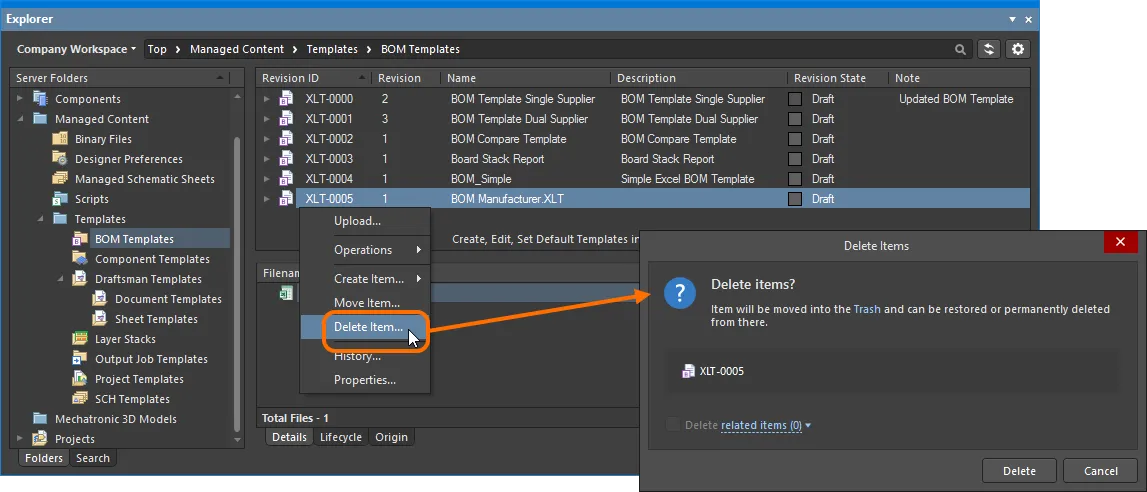
Soft deletion of a BOM template. The template will be moved to the Workspace's Trash area.
To proceed with the deletion, click the  button. The BOM template will be removed and a Deletion Summary dialog will confirm successful deletion. If there was an issue with deletion, this will be flagged to you.
button. The BOM template will be removed and a Deletion Summary dialog will confirm successful deletion. If there was an issue with deletion, this will be flagged to you.
All content deleted in this manner can be found on the Trash page of the Workspace's browser interface. Note that you can only view content that you have personally soft deleted. Administrators will be able to see the full content of the Trash page – so all content that has been soft deleted.
Things to consider in relation to a soft deleted BOM template:
- The BOM template will not be available from your design software, or from within the Web interface.
- Anywhere the BOM template was being used will reflect that the template has been deleted.
- A BOM template can be restored, or permanently deleted from the Trash page, provided you have editing rights. Permanent deletion is only possible provided it is not being used by a parent Item.
Note that if you have soft deleted a BOM template – moving it to the Trash – you can create a new BOM template with that same name again. If you were to subsequently restore the original BOM template, and the original name is taken, an integer suffix will be used, to keep its name unique within the Workspace.